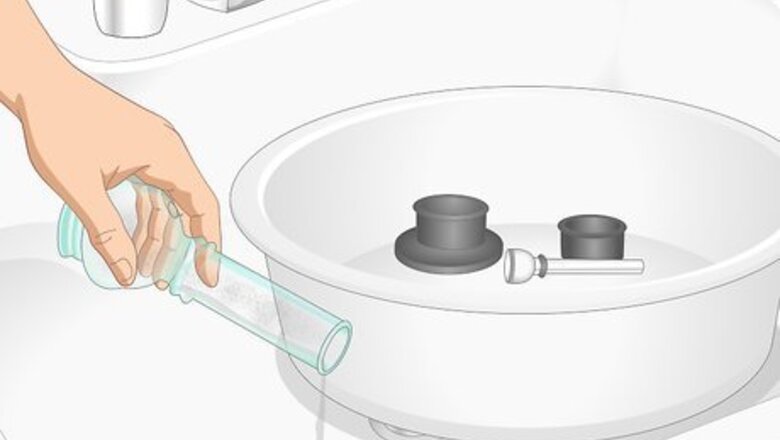
views
Using Rubbing Alcohol and Salt
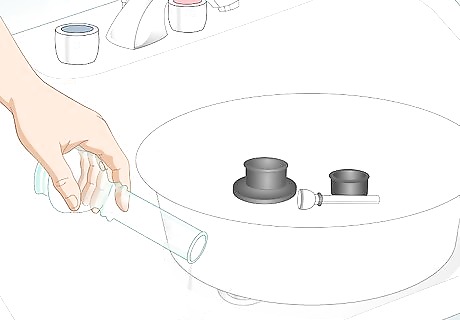
Dump out the dirty water and separate the pieces of your bong. If there is any water leftover in the base of your bong, go ahead and empty it into the sink through the slide. Depending on what kind of a bong you have, you may be able to detach the mouthpiece and chamber from the base, or the bowl may slide out. Breakdown the bong as much as you can. Avoid emptying the dirty water through the mouthpiece, as that could introduce mold or bits of resin to its edges.

Rinse out the mouthpiece, chamber, and base with hot water. Swirl the water around a bit and dump it out through the slide. Doing this causes leftover resin to start loosening up. Because you’re working with an acrylic bong, you don’t need to worry about the water getting too hot. With glass bongs, too great of a temperature difference between the bong itself and the water can cause the bong to crack or shatter.

Put each piece of the bong into its own plastic container. Use either resealable plastic bags or plastic containers with lids. Make sure the container is large enough to hold the piece even after it has been sealed. Keeping the pieces separate simply helps them get clean faster.

Add rubbing alcohol and salt to each plastic container. Opt for a 70% rubbing alcohol—it won’t evaporate as quickly and is less abrasive than the higher-percentage rubbing alcohols. For the smaller bong parts, use ⁄4 cup (59 mL) of rubbing alcohol and 1 tbsp (17 grams) of salt. For bigger pieces, use ⁄2 cup (120 mL) of rubbing alcohol and 2 tbsp (34 grams) of salt. These measurements don’t have to be exact—just make sure there is enough liquid in the bag to cover the bong piece. You can use whatever kind of salt you have on hand. Table salt will more easily get into small crevices, whereas sea salt can provide a little more scrubbing power because each grain is bigger. Rubbing alcohol breaks down the resin that has built up in the bong. Salt is abrasive and makes it easier to scrub away the resin and any mold that has grown.
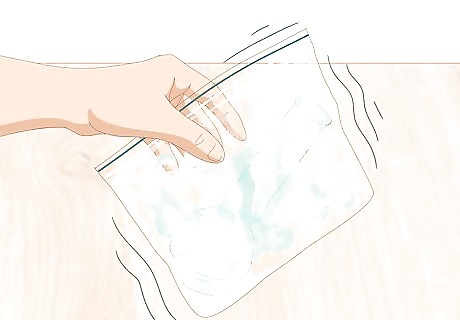
Seal and shake the containers to start the cleaning process. Vigorously shake each bag or container for 3-5 minutes to work the alcohol and salt through the pieces. The resin is sticky and you need to work hard to dislodge it. Stop shaking the containers either at the 5-minute mark or when you can visibly see that the resin is starting to come off of the bong. Once you get into a routine of regularly cleaning your acrylic bong, it’ll be easier to do every time. There won’t be as much built-up resin, so it won’t take as long to dislodge.
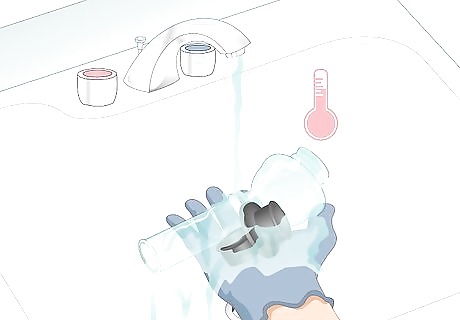
Rinse all the pieces with hot water and scrub away any residual resin. Remove the bong pieces from the containers and rinse them off with hot water from the tap. Use Q-tips or a bottle-scrub brush to get into all the cracks and crevices to manually clean off anything that remains. If you use resealable plastic bags, dump out the dirty alcohol and salt mixture and throw the bags away. If you used plastic containers, dump out the liquid and clean them with soapy water before you use them again.Tip: Wear rubber gloves during this part of the process. They’ll protect your hands and allow you to use hotter water than you would be able to without them.

Dry off the bong and all its pieces completely before using it again. Use paper towels or a clean hand towel to soak up the majority of the excess water. Then let the bong sit out on a clean hand towel for a few hours so any remaining water can evaporate. Leftover water could cause mold to develop, so you must store your bong completely dry.
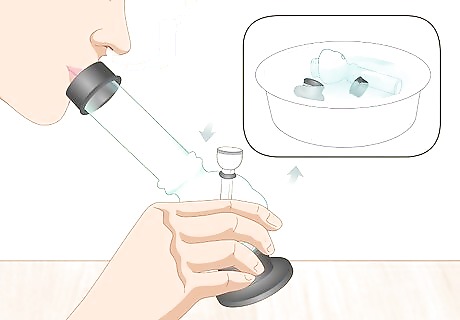
Clean your bong after every 1-2 smokes to keep it in good condition. How often you should clean your bong depends on how often you smoke. If you smoke occasionally, like once a week, you should clean your bong after every session. If you smoke multiple times a week, try to clean your bong every 48 hours. You may think that if you smoke infrequently, you don’t need to clean your bong out often, but you should actually clean it every time you use it. That time between each smoke is when your bong could grow some funky bacterias. At a minimum, at least empty the dirty water from your bong after each use. Signs That It’s Time to Clean Your Bong: Slimy film Resin build-up Brown water White or black specks in the chamber or base Swampy smell
Cleaning with Baking Soda and Vinegar

Separate the pieces of your bong so you can clean each one thoroughly. Take the bowl out of the slide and detach any other pieces that come apart. Some acrylic bongs have multiple pieces that can be removed, whereas others stay primarily in one piece.

Pour out the dirty water and rinse the bong with hot water. Empty the remaining dirty water through the slide and rinse out the entire bong with really hot water. Do your best to always empty the water through the slide rather than through the mouthpiece so mold and resin can’t make their way up there. The hot water starts to loosen built-up resin or mold, plus it can dislodge any slime that may have developed.
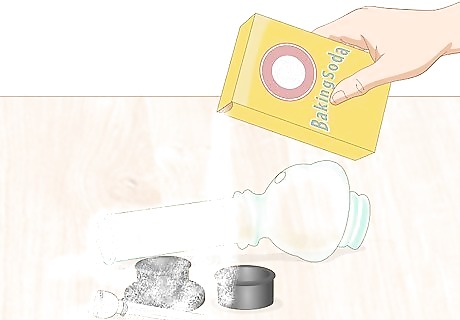
Coat the inside and outside of each piece with baking soda. Rinse the pieces with hot water again if they’ve already dried off, then sprinkle baking soda over them so that they’re lightly coated. The water helps the baking soda stick to the bong. If there are sections that have a lot of build-up, go ahead and add some extra baking soda to those areas.

Put the pieces into a shallow container and let them sit for 10-15 minutes. Set a timer and let the baking soda saturate the grime, resin, and mold. There’s no need to do anything else at this point. Baking soda is an abrasive and it breaks down dirt and grime, making it a great natural product to use to clean things.
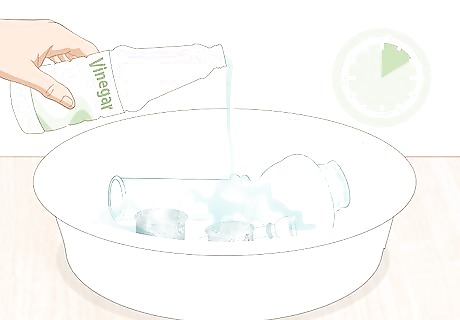
Cover the bong pieces with white vinegar for another 10 minutes. Simply pour enough vinegar into the shallow plastic container to completely cover all the parts of the bong. You’ll notice that the baking soda and white vinegar fizz when they come into contact—this just means that they are reacting and starting to cut through the resin and grime. Generally, once the mixture stops fizzing you can go ahead and move on with the cleaning process. It won’t hurt anything if you leave things to soak for a little longer, though.Tip: Sometimes the fizzing can bubble out of the container, just depending on how shallow it is. Lay a towel underneath of the container to catch any spillage.
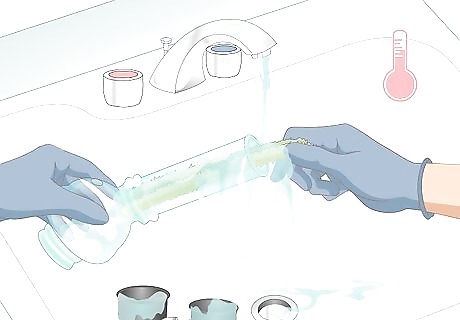
Rinse the bong with hot water and scrub away resin with a pipe cleaner. Run each piece of your acrylic bong underneath hot water. Use something like a pipe cleaner or bottle-scrub brush to dislodge and wipe away any resin or mold. Keep rinsing and scrubbing until the entire bong is clean. Try wearing rubber gloves during this stage so that you can use hotter water than you’d normally be able to. The rubber helps insulate your hands from the heat so they can withstand higher temperatures.

Dry your bong completely so that it doesn’t grow any mold. Once the bong is clean, use paper towels or a clean hand towel to dry it off. Give it a few hours to air dry, too, in case there were sections inside you couldn’t reach. Always store your bong dry—a wet bong is a breeding ground for bacteria and mold.
Getting Rid of Hard Water Stains
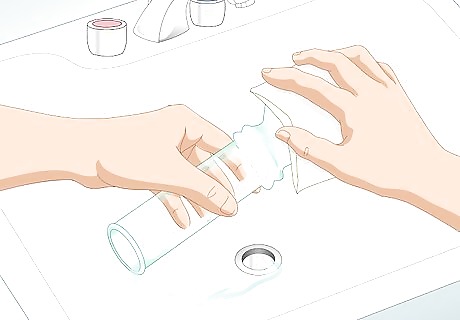
Clean and dry your bong before treating hard water stains. If you notice hard water stains after you’ve cleaned your bong, you can use lemon juice and hot water to get rid of them. Water stains can make your bong look dirty even when it isn’t. It may take a few sessions to get all the hard water stains off, just depending on how bad they were to begin with.

Pour hot water and lemon juice in the bong’s main chamber. Use about 1 tablespoon (15 mL) of lemon juice and enough water to cover the stained areas. Use either fresh lemon juice or bottled—the result will be the same. Use the hottest water you can get from the tap. Since you’re working with an acrylic bong rather than a glass one, you don’t need to worry about accidentally cracking or shattering your bong.Tip: Add 2 drops of lemon juice to your bong water the next time you smoke. It’ll help prevent hard water and resin build-up. Don’t add much more than 2 drops though, as the lemon could overwhelm the flavor of your weed.

Swirl the lemon juice and water around for 60 seconds. Gently swish and swirl the mixture around in your bong so that the lemon can saturate all of those hard water stains. If the bong is too hot to handle, wear rubber gloves or hold it with a towel. This process also makes your bong smell nice and clean.
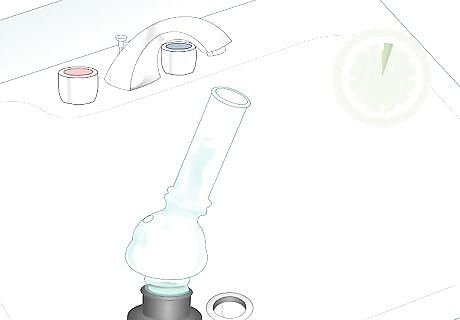
Let the hard water stains soak in the hot water for 2-3 minutes. Leave your bong alone for a few minutes so the lemon and water can continue breaking down the water stains. Set a timer so you don’t forget to go back and finish the process.

Rinse out the bong with more hot water. Dump out the water and lemon juice and run clean hot water through the bong to completely wash away the debris. Use the hottest tap water you can without burning yourself.Tip: Water stains are usually caused by hard tap water. To keep your bong clean, use distilled or filtered water for your smoking sessions moving forward.
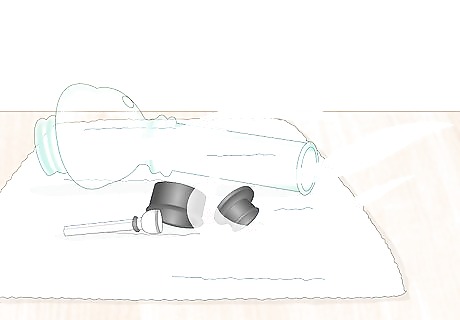
Let the bong dry completely. Lay it out somewhere to dry and make sure all of the moisture has evaporated before you put it away somewhere. Excess water can cause more water spots or could even make different bacterias grow. You could even use paper towels or a clean hand towel to remove most of the excess moisture from the bong.















Comments
0 comment